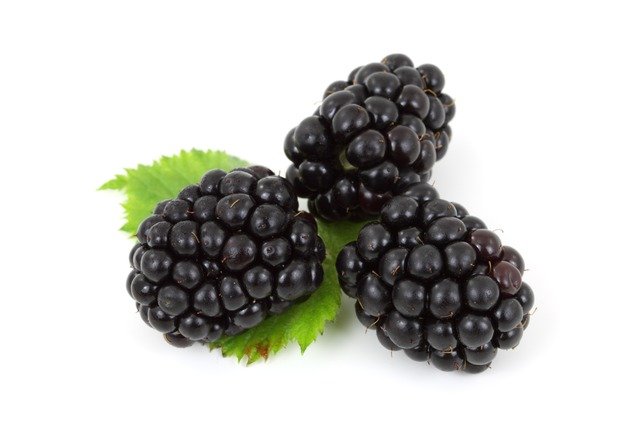
The blackberry is actually an aggregate fruit which is consisting of some smaller fruits known as drupes. The fruit is extremely dark purple and has a smooth, delicate skin. The blackberry contains a greenish-white core which reaches near the bottom. Blackberries are usually wrongly identified as raspberries. However, raspberries contain a hollow center. When raw, blackberries are red in color and hard, and change to black and shiny once they ripen.
The blackberry tree has a number of long, trailing or arching stems (known as canes). The berries are grown on two year-old canes. The blackberry may reach as high as 10 feet. The canes are pale green with thorns; even so, you may find thornless species.
The leaves of blackberry are structured alternately along the cane and each and every leaf comprises 3-5 leaflets. The compound leaves can be seen intensely toothed along the edges, fairly prickly, and in bright green.
Health Benefits of Eating Blackberries
Blackberry Antioxidants
Vitamin C functions as an antioxidant, and a cup of the berries makes up half the daily allowance of vitamin C. Our body applies vitamin C to build stronger immune system, and vitamin C reduces the chance of developing cardiovascular disease, certain kinds of cancer, as well as macular degeneration. Vitamin C helps wound healing, and research has revealed vitamin C could possibly reduce the presence of wrinkles.
Blackberries feature ellagic acid, a powerful antioxidant which has been proven to shield our skin from harm by ultraviolet. New scientific studies discover that ellagic acid not only prevents our skin from harm, but also fix skin hurt by sunlight. Furthermore, based on the American Cancer Society, research has revealed that ellagic acid contains anti-cancer properties.
Anthocyanins are compounds that provide blackberries with the dark color. They are found to diminish inflammation. Being an antioxidant, anthocyanins assist in combating free radicals in our body that damage cells and cause illnesses including cancer and cardiovascular disease.
Phytoestrogens in Blackberries
Phytoestrogens are naturally sourced plant estrogens that help ease the typical symptoms of PMS such as bloating, hunger, and relieve menopausal symptoms like hot flashes. Phytoestrogens can also help with immune and brain functioning and heart wellbeing.
Dietary Fiber in Blackberries
A cup of blackberries consists of 8 g of dietary fiber, attaining 31 percent of the daily recommended volume. Dietary fiber boosts healthy digestive function and may reduce the risk of getting specific diseases like cardiovascular disease and diabetes. Studies have also discovered that dietary fiber helps weight loss.
Vitamin K in Blackberries
Blackberries are rich in vitamin K, providing 36 percent of the daily recommended quantity. Vitamin K is normally applied by our body for blood clotting and to help in absorption of calcium.
Blackberry Nutrition Facts and Calories
| Nutrition Value of 1 Cup (144 g) Raw Blackberries | |
| Calories | 62 kcal |
| Total Fat | 1 g |
| Cholesterol | 0 mg |
| Sodium | 1 mg |
| Total Carbohydrates | 15 g |
| Dietary Fiber | 8 g |
| Sugars | 7 g |
| Protein | 2 g |
How to Choose and Buy Blackberries?
- Select berries that are deeply-colored, glossy and plump. Avoid blackberries that are bruised.
- Look into the container for stains, which show spoiled berries on the bottom. If you can, try out some to assure they are not too sour.
How to Store Blackberries?
- Sort out and dispose of any bruised or spoiled berries. Handle properly. Store unwashed blackberries in a shallow container and cover using paper towel. Put in the fridge for approximately 2 days.
Blackberry Side Effects
There is no known negative effects of blackberries when used as a food.
About the author: Martin M Dotson, a content writer at the essay writing service. He is keen on reading detective novels and learning foreign languages. So he has a dream to go to all countries and meet new people.







